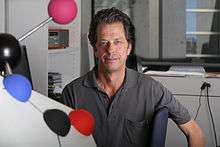Tilman Schirmer
| Tilman Schirmer | |
|---|---|
 Tilman Schirmer (2011) | |
| Nationality | German |
| Fields | Structural biologist |
| Institutions | University of Konstanz, University of Vienna, Ludwig Maximilian University of Munich, Max Planck Institute of Biochemistry, Laboratory of Molecular Biology, Biozentrum University of Basel |
Tilman Schirmer is a structural biologist and Professor at the Biozentrum of the University of Basel.
Life
Tilman Schirmer studied physics at the Universities of Konstanz and Vienna, and at the Ludwig Maximilian University of Munich. In 1985 he earned his doctorate at the Max Planck Institute for Biochemistry in Martinsried.[1] He subsequently conducted research at the MRC Laboratory of Molecular Biology in Cambridge, England. In 1989 Tilman Schirmer came to the Biozentrum, University of Basel, initially as a group leader. Since 1997, he holds he position of Associate Professor of Structural Biology at the Biozentrum Basel.[2]
Work
Tilman Schirmer investigates the mechanism of action of bacterial proteins based on their spatial structures, which are determined using X-ray crystallography. This has provided insights into light harvesting in photosynthetic antenna complexes, the allosteric regulation of phosphofructokinase and the translocation of small molecules through the porins of the outer membrane. As of 2013, Tilman Schirmer’s research group[3] at the Biozentrum in Basel is studying the mechanisms of signal transduction of the messenger substrate cyclic di-GMP and the structure-function relationships of bacterial effector proteins with AMP-transferase activity. The goal is the elucidation of fundamental biological interrelationships on the molecular level.[1]
Awards and honors
- 1986 Otto Hahn Medal of the Max Planck Society
- 1988 Long-Term Fellowship of the European Molecular Biology Organization (EMBO)
External links
- Official website
- Bookchapter in "Bacterial and Eukaryotic Porins: Structure, Function, Mechanism" by Roland Benz in wiley online library. Retrieved 2013-11-03.
References
- 1 2 "Projects of the research group Tilman Schirmer". Biozentrum.unibas.ch. Retrieved 2013-12-03.
- ↑ "Curriculum Vitae". Biozentrum.unibas.ch. Retrieved 2013-12-04.
- ↑ "Research group Tilman Schirmer". Biozentrum.unibas.ch. Retrieved 2013-12-03.